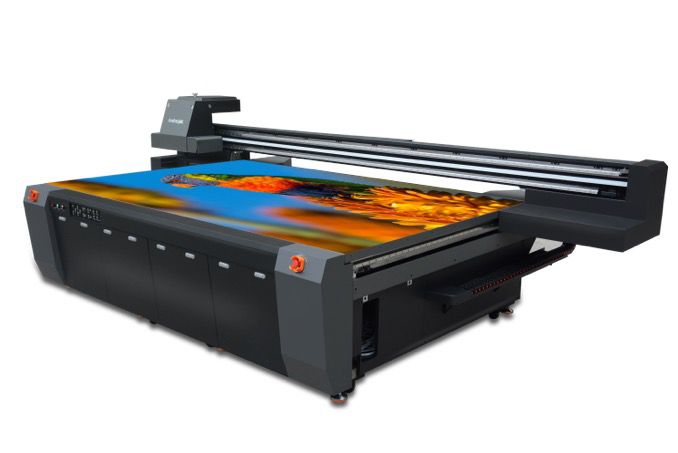UV Flatbed Printer: Comparison with Other Printing Technologies
UV Flatbed Printer: Comparison with Other Printing Technologies
In the realm of digital printing, UV flatbed printers have emerged as a formidable technology, offering versatility, precision, and efficiency that rival traditional and other modern printing methods. This article delves into the specifics of UV flatbed printing, highlighting its unique advantages and comparing it with other prevalent printing technologies such as screen printing, offset printing, and digital inkjet printing. By examining their respective applications, cost-effectiveness, print quality, and versatility, we aim to provide a comprehensive understanding of why UV flatbed printers are becoming a preferred choice for various industries.

Understanding UV Flatbed Printing
UV flatbed printers utilize ultraviolet (UV) light to instantly cure or dry ink as it is applied onto the substrate. This process allows for immediate fixing of the ink, enabling printing on a wide range of materials including plastics, glass, metal, wood, and even flexible materials like leather and fabric. The technology employs a flatbed platform where the object to be printed is placed, allowing for direct and precise printing without the need for additional fixtures or plates.
One of the key advantages of UV flatbed printing is its ability to produce high-resolution prints with vibrant colors and sharp details. The inks used are specially formulated to be cured by UV light, resulting in durable prints that are resistant to fading, scratching, and environmental factors. This makes UV flatbed printing ideal for applications requiring long-lasting and high-quality graphics, such as product labeling, signage, and decorative items.
Comparison with Screen Printing
Screen printing, also known as silkscreen printing, is a traditional method that involves creating a stencil (or screen) for each color to be printed. Ink is then pushed through the screen onto the substrate using a squeegee. While screen printing is cost-effective for large-scale production of simple designs, it lacks the flexibility and versatility offered by UV flatbed printing.
Versatility: UV flatbed printers can print on almost any material and accommodate variable print sizes easily, whereas screen printing requires custom screens for each design and color, limiting its adaptability.
Print Quality: UV flatbed printing produces sharper images with a wider color gamut, while screen printing may result in slightly blurred edges and limited color range.
Setup Time and Cost: Screen printing involves a longer setup process, especially for multi-color designs, making it less suitable for short-run or on-demand printing. UV flatbed printing, on the other hand, offers quick setup and is more cost-effective for smaller print volumes.
Comparison with Offset Printing
Offset printing is a widely used industrial printing process where the inked image is transferred (or “offset”) from a plate to a rubber blanket, then to the printing surface. It is known for its ability to produce high-quality prints at high speeds, making it suitable for large-volume printing projects such as newspapers, magazines, and packaging.
Print Volume: Offset printing excels in high-volume production due to its speed and efficiency. UV flatbed printing, however, is more suited for shorter runs or customized printing where flexibility is crucial.
Setup and Cost: Offset printing requires significant setup costs, including plate making and ink mixing, making it less economical for small print jobs. UV flatbed printing offers a more cost-effective solution for these scenarios.
Material Compatibility: While offset printing is limited to certain types of paper and cardboard, UV flatbed printing can accommodate a broader range of materials, including rigid and flexible surfaces.
Comparison with Digital Inkjet Printing
Digital inkjet printing is another popular technology that directly applies ink to the substrate using a series of nozzles. It offers versatility in terms of print size and design changes but differs from UV flatbed printing in several aspects.
Ink Curing: Traditional digital inkjet printers use aqueous or solvent-based inks that require time to dry. UV flatbed printers, on the other hand, cure the ink instantly with UV light, allowing for immediate handling and finishing.
Print Durability: The UV-cured inks used in flatbed printing result in more durable prints that are resistant to fading and scratching, making them suitable for outdoor and industrial applications.
Cost and Efficiency: For large-format printing, UV flatbed printers are often more cost-effective due to their faster printing speeds and reduced ink consumption compared to some digital inkjet printers.
Conclusion
UV flatbed printing stands out as a versatile and efficient technology that bridges the gap between traditional and digital printing methods. Its ability to print on various materials, produce high-quality graphics, and offer quick setup and curing times makes it a preferred choice for a wide range of applications. While other printing technologies excel in specific areas such as large-volume production (offset printing) or cost-effectiveness for simple designs (screen printing), UV flatbed printing offers a unique combination of versatility, print quality, and durability that is hard to match.
As technology continues to advance, UV flatbed printers are expected to become even more accessible and affordable, further expanding their reach into various industries. For businesses seeking a reliable and adaptable printing solution that can accommodate diverse needs, UV flatbed printing presents a compelling option that combines the best of both traditional and modern printing technologies.
